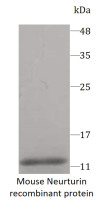ARG70459
Mouse Neurturin recombinant protein (Active) (His-tagged, N-ter)
Mouse Neurturin recombinant protein (Active) (His-tagged, N-ter) for SDS-PAGE
Overview
| Product Description | E. coli expressed, His-tagged (N-ter) Active Mouse NRTN recombinant protein |
|---|---|
| Tested Application | SDS-PAGE |
| Target Name | NRTN |
| Species | Mouse |
| A.A. Sequence | Cys101 - Val195 |
| Expression System | E. coli |
| Protein Full Name | Neurturin |
| Activity | Active |
| Activity Note | Determined by its ability to induce proliferation in SH-SY5Y cells. The ED50 for this effect is < 50 ng/mL. |
| Alternate Names | NRTN; Neurturin; NTN; Prepro-Neurturin |
Properties
| Form | Powder |
|---|---|
| Purification Note | Endotoxin level is less than 0.1 EU/µg of the protein, as determined by the LAL test. |
| Purity | > 98% (by SDS-PAGE) |
| Buffer | PBS (pH 7.4) |
| Reconstitution | It is recommended to reconstitute the lyophilized protein in sterile water to a concentration not less than 200 μg/mL and incubate the stock solution for at least 20 min at room temperature to make sure the protein is dissolved completely. |
| Storage Instruction | For long term, lyophilized protein should be stored at -20°C or -80°C. After reconstitution, aliquot and store at -20°C or -80°C for up to one month. Storage in frost free freezers is not recommended. Avoid repeated freeze/thaw cycles. Suggest spin the vial prior to opening. |
| Note | For laboratory research only, not for drug, diagnostic or other use. |
Bioinformation
| Gene Symbol | NRTN |
|---|---|
| Gene Full Name | Neurturin |
| Background | This gene encodes a secreted ligand of the TGF-beta (transforming growth factor-beta) superfamily of proteins. The encoded preproprotein is proteolytically processed to generate the mature protein. This protein signals through the RET receptor tyrosine kinase and a GPI-linked coreceptor, and promotes survival of neuronal populations. A neurturin mutation has been described in a family with Hirschsprung Disease. |
| Function | Supports the survival of sympathetic neurons in culture. May regulate the development and maintenance of the CNS. Might control the size of non-neuronal cell population such as haemopoietic cells. |
| Cellular Localization | Secreted |
| PTM | Disulfide bond |
Images (1) Click the Picture to Zoom In






